Alexandria and Washington Railroad
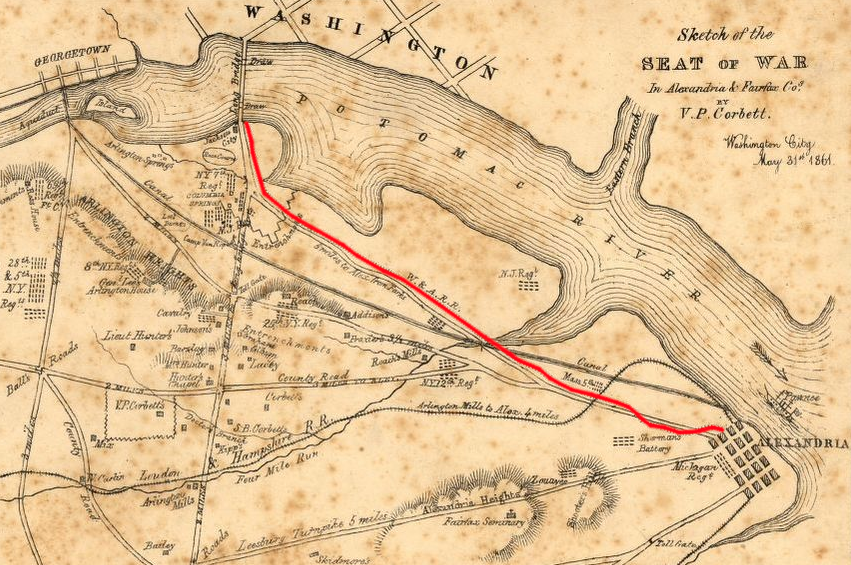
at the start of the Civil War, the Alexandria and Washington Railroad ran from Long Bridge to Alexandria, with no direct track connection to any other railroad
Source: Library of Congress, Sketch of the seat of war in Alexandria & Fairfax Cos. (by V. P. Corbett, 1861)
Soon after the retrocession of Alexandria back to Virginia in 1847, Northern Virginia investors financed construction of railroads from their port city to the Virginia Piedmont and Shenandoah Valley. Trains offered lower transportation costs, so farmers shipped to Aleandria and purchased finished goods from merchants in that city.
Building a railroad northwest of the city parallel to the Potomac River, or south along the Fall Line to Fredericksburg, were low priorities. Those routes would not boost business as much as linking the port to the coal fields in Hampshire County or to the wheat farms in Rockbridge County.
It was not until February 27, 1854 that the General Assembly granted a charter for the Alexandria and Washington Railroad, including the right to purchase the Alexandria Canal Company and the Alexandria and Washington Turnpike. The US Congress authorized construction within the District of Columbia, and track from the northern end of the Long Bridge to a connection with the Baltimore and Ohio Railroad was completed in 1855.
The railroad built from Alexandria to Jackson City on the southern end of Long Bridge in 1857. Operations started on January 1, 1858. On the north side of the Potomsac River, track was constructed from Long Bridge to the Baltimore and Ohio Railroad depot.
Freight had to be unloaded from railroad cars, placed on wagons to cross Long Bridge, and then be reloaded onto railroad cars on the other end. There was minimal space for laying track on the bridge itself, and it was not believed to be strong enough to support locomotives. The absence of rails across Long Bridge created an inefficient gap in the Alexandria and Washington Railroad. Long Bridge has been a chokepoint from the beginning, but it was not until 2020 that the Commonwealth of Virginia decided to build a second railroad bridge across the Potomac River to increase rail capacity.
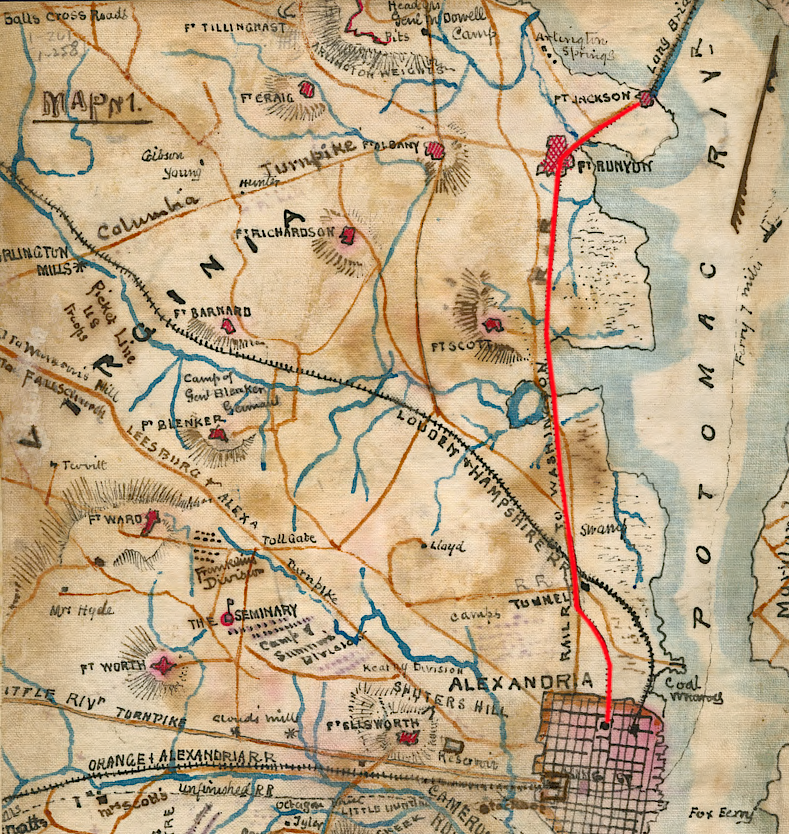
the Alexandria and Washington Railroad started operations three years before the Civil War
Source: Library of Congress, [Map of Alexandria, Virginia] (by Robert Knox Sneden, 1861-65)
The initial Alexandria and Washington Railroad was built using an innovative technology patented by James S. French, president of the railroad. The iron straps used for rails were laid on stringers notched into the ties ("sleepers"), and the iron strap was wide enough to extend beyond the edge of the stringer. The locomotive wheels were designed to engage the bottom of the iron strap, providing greater adhesion and permitting trains to move up steeper grades with lighter locomotives. Iron strap rail was still in common use, though the T-shaped rail now used by almost all ralroads had been developed two decades earlier.
A test of James S. French's design had been conducted earlier in Manchester, south of Richmond. That test was successful, but the unique technology was quickly abandoned on the Alexandria and Washington Railroad.
The advantages of French's design were not evident on the particular topography faced by the Alexandria and Washington Railroad. There was minimal change in elevation on the route along the shoreline of the Potomac River in Virginia, or from the end of Long Bridge to the Baltimore and Ohio Railroad depot in Washington, DC.
1
1
William Bender Wilson, History of the Pennsylvania Railroad Company, Volume 1, Sherman Press, 1895, pp.346-353, pp.429-433, pp.435-437 https://books.google.com/books?id=qj9N-eWi71YC; "Timeline of Washington, D.C. Railroad History," Washington DC Chapter National Railway Historical Society, http://www.dcnrhs.org/learn/washington-d-c-railroad-history/timeline-of-washington-d-c-railroad-history; "An Archeological Assessment of the Southern Plaza Project Area Alexandria, Virginia," John Milner Associates, 1988, p.12, https://www.alexandriava.gov/uploadedFiles/historic/info/archaeology/SiteReportSeifertSouthernPlazaUSMRR.pdf; John F. Stover, American Railroads, University of Chicago Press, 1997, p.21, https://www.google.com/books/edition/_/aPNQXN9Onv4C (last checked May 29, 2020)
The Alexandria and Washington Railroad was not profitable at the end of the 1850's. Alexander Hay, from Philadelphia, loaned money to James French. He obtained in the arrangement the authority over other unpaid debts owed by the business.
On May 24, 1861, at the start of the Civil War, Union troops occupied Alexandria. James S. French was a Confederate sympathizer, unwilling to cooperate with the invading army. He had the Alexandria and Washington Railroad's rolling stock hauled to the Orange and Alexandria (O&A) Railroad, where they could get to Manassas and avoid capture by the Union forces. The logistics of the equipment transfer of equipment must have required quick action, since no track linked the Alexandria and Washington Railroad terminal on Fayette Street to the Orange and Alexandria Railroad terminal a block away.
The US military immediately seized the Alexandria and Washington Railroad. All the rails were removed and the roadbed was converted into a path for troops and wagons. Removing the rails was a mistake; trains were more efficient in moving supplies to support the forces occupying Alexandria and in nearby camps. The US Military Railroad chose to rebuild the railroad by February, 1862. To simplify operations, the US Military Railroad connected the Alexandria and Washington Railroad tracks to the Alexandria, Loudoun and Hampshire Railroad.
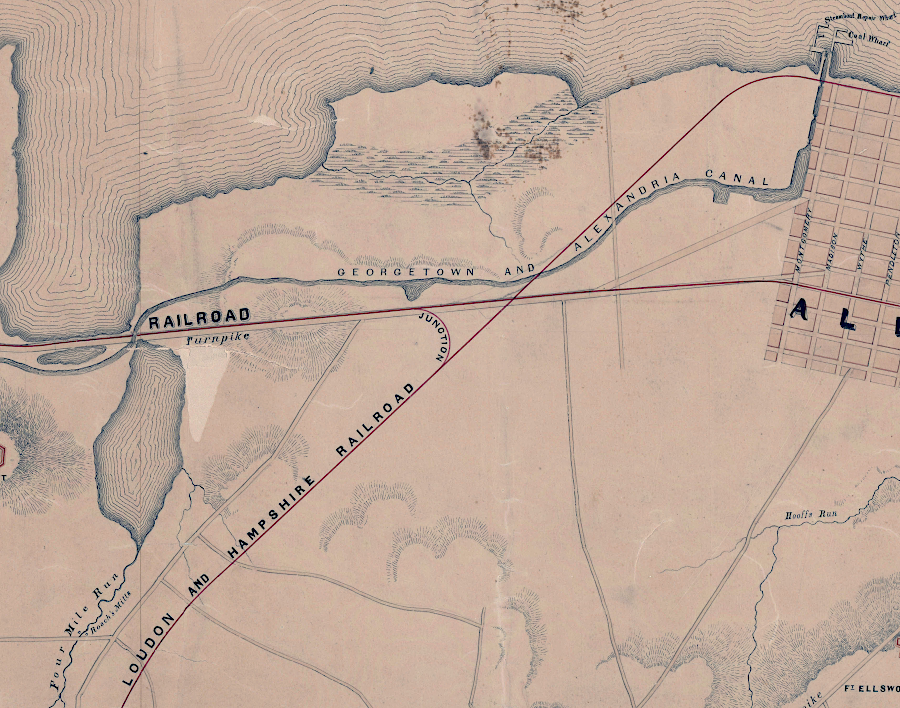
the Alexandria and Washington Railroad was conected to the Alexandria, Loudoun and Hampshire Railroad by the Union Army during the Civil War
Source: National Archives, Map of the Washington and Alexandria Railroad and its Connections with the Baltimore and Ohio, Loudon and Hampshire Orange and Alexandria Railroads (May 1865)
The military also built a connection from the Alexandria and Washington Railroad to the Orange and Alexandria Railroad, creating the first Alexandria Junction.
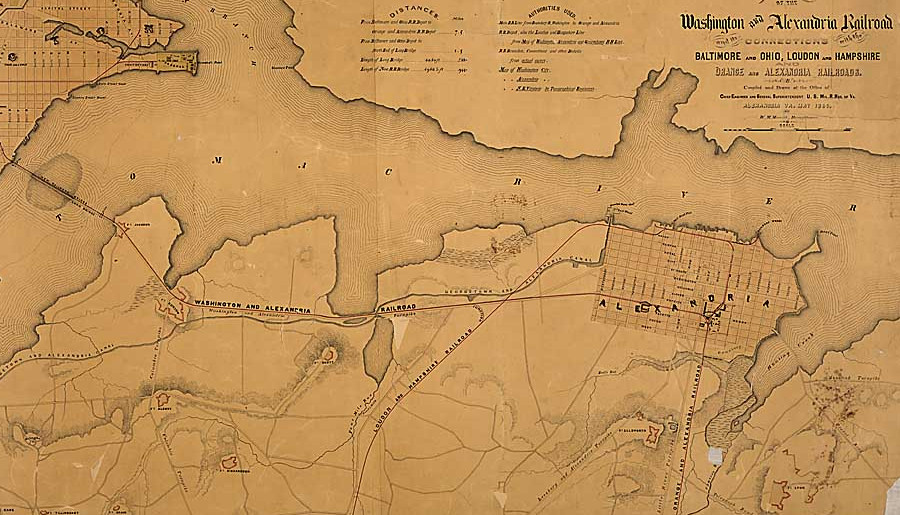
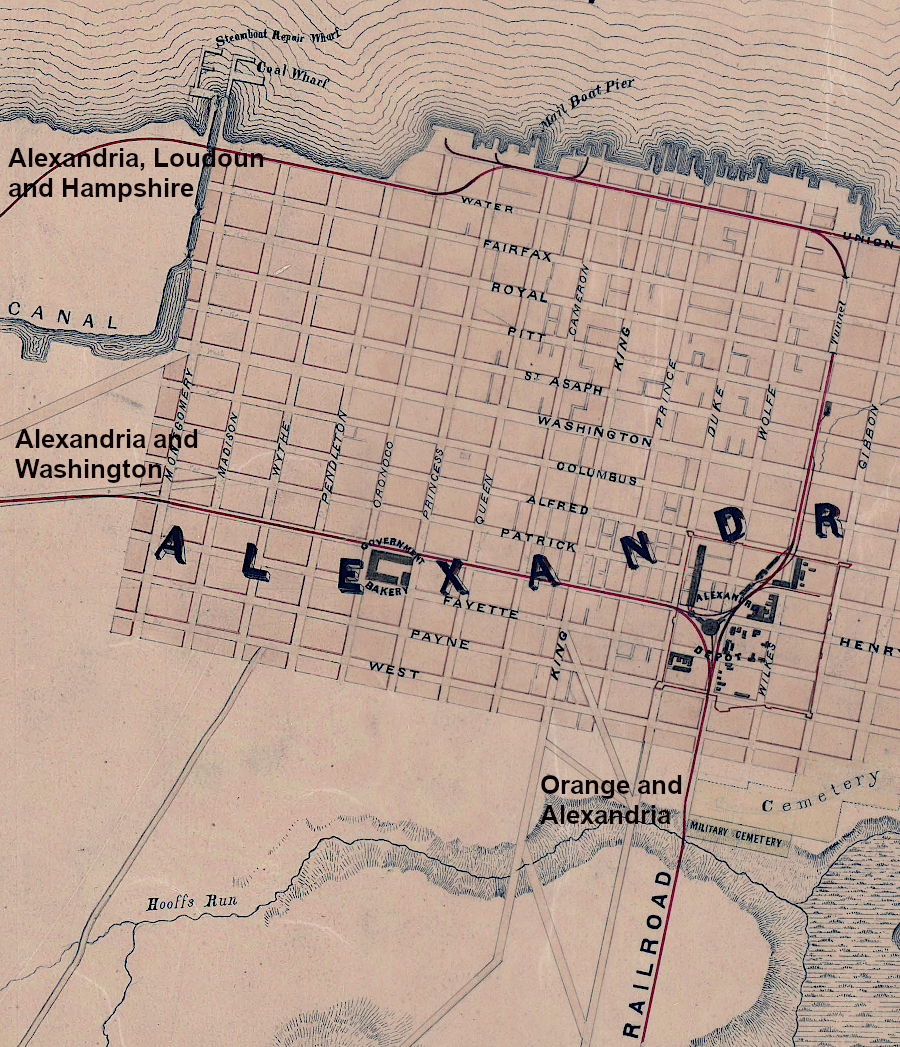
the US Military Railroad rebuilt the Washington and Alexandria Railroad in 1862, and connected it directly to the Alexandria, Loudoun and Hampshire Railroad and the Orange and Alexandria Railroad
Source: National Archives, Map of the Washington and Alexandria Railroad and its Connections with the Baltimore and Ohio, Loudon and Hampshire, and Orange and Alexandria Railroads (1865); Map of the Washington and Alexandria Railroad and its Connections with the Baltimore and Ohio, Loudon and Hampshire Orange and Alexandria Railroads (May 1865)
Track was also placed on the Long Bridge in 1862, allowing rail cars with freight to cross the river without being unloaded. Because the bridge was so light, engineers planned to use horses rather than heavy locomotives to pull the loaded cars across the bridge. After just one day, the horses were replaced with locomotives.
With rails across the Potomac River, freight cars could finally move directly from the Baltimore and Ohio Railroad within the District to Alexandria. The US Military Railroad was operating primarily on the tracks of the Orange and Alexandria Railroad, and it built the track inside Alexandria that was needed to link up the different railroads that entered the city. During the Civil War the US Military Railroad built railroad tracks along the waterfront. Union forces created an early version of shipping containerized cargo from Alexandria. The US Military Railroad placed rails on barges to create car floats, pushed loaded rail cars onto the car floars, and barged supplies inside those rail cars downstream to the railhead at Aquia Landing east of Fredericksburg.1
William Bender Wilson, History of the Pennsylvania Railroad Company, With Plan of Organization, Portraits of Officials and Biographical Sketches, Henry T. Coates (publisher), 1899, pp.435-437, https://www.google.com/books/edition/History_of_the_Pennsylvania_Railroad_Com/qj9N-eWi71YC?; Jay Roberts, "Rails in the Seaport: A Brief Look at the History of Railroads and Their Tracks in Alexandria," Jay's Jottings blog, January 28, 2015, https://jay.typepad.com/william_jay/2015/01/rails-in-the-seaport-a-brief-look-at-the-history-of-railroads-and-their-tracks-in-alexandria.html (last checked January 6, 2025)
In 1862, after the original stockholders and managers had moved into parts of Virginia controlled by the Confederate state government, the Alexandria and Washington Railroad was "sold" by a trustee to Alexander Hay. Since James French had fled south, he could not protect his claim to the railroad until after 1865. Hay and French ended up engaging in protracted legal disputes in Virginia, the District of Columbia, and Pennsylvania. The legal status of the Alexandria and Washington Railroad remained complicated until 1890.
In 1862, Hay also got the pro-Union Restored Government of Virginia, based in Wheeling instead of Richmond, to charter a new railroad with the same rights as the Alexandria and Washington Railroad. The Washington, Alexandria and Georgetown Railroad essentially replaced the 1854 Alexandria and Washington Railroad. In 1863 the pro-Union investors in the Washington, Alexandria and Georgetown Railroad also got a charter from the US Congress to build track in the District of Columbia. That track connected the north end of Long Bridge to the Baltimore and Potomac Railroad depot, located where the National Gallery of Art now stands.
The Washington, Alexandria and Georgetown Railroad was granted the right to lay track on a new Long Bridge across the Potomac River, built parallel to the old Long Bridge. Congressional action was required; the Virginia General Assembly meeting in Wheeling could not authorize that new bridge because all of the Potomac River beyond the high water mark was within the District of Columbia.

in 1861, the Washington and Alexandria Railroad (red line) did not have tracks across Long Bridge
Source: Library of Congress, Topographical map of Virginia between Washington and Manassas Junction (by Charles Magnus, c.1861)
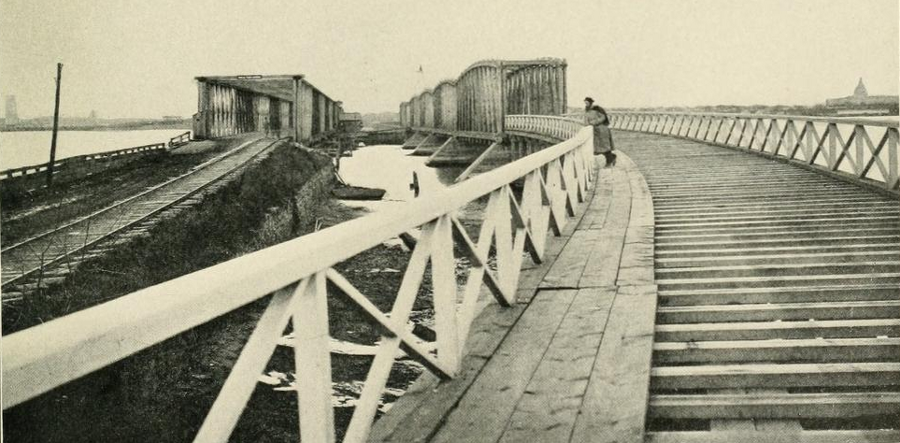
during the Civil War, the Washington, Alexandria and Georgetown Railroad was authorized to operate over a new Long Bridge
Source: The Photographic History of the Civil War, Political Objectives - Washington (p.123)
The General Assembly of the pro-Union Restored Government of Virginia moved to Alexandria when the new state of West Virginia was created in 1863. On February 3, 1864, the General Assembly for the "loyal" government of Virginia, meeting in Alexandria, chartered the Alexandria and Fredericksburg Railroad. That new company was owned by the same Union-supporting investors who had purchased the Alexandria and Washington Railroad and obtained a charter for the Washington, Alexandria and Georgetown Railroad in 1862.
The Alexandria and Fredericksburg Railroad was granted the right to extend the Washington, Alexandria and Georgetown Railroad further south from Alexandria to a planned junction with the Richmond, Fredericksburg and Potomac Railroad near Fredricksburg.
After the conclusion of the Civil War, James French and another original investor in the Alexandria and Washington Railroad sued in a Virginia court and regained control, based on their 1854 charter. The state court voided the 1862 bankruptcy sale, and it also ruled that the Washington, Alexandria and Georgetown Railroad had never been a legal corporation in Virginia.
French renamed his recovered property the Washington and Alexandria Railway, and he advanced an even more ambitious claim that he was entitled to all the assets of the Washington, Alexandria and Georgetown Railroad. He sued to gain control over the track laid on the Long Bridge during the Civil War, and the short section of track in Washington, DC still controlled by the Washington, Alexandria and Georgetown Railroad.
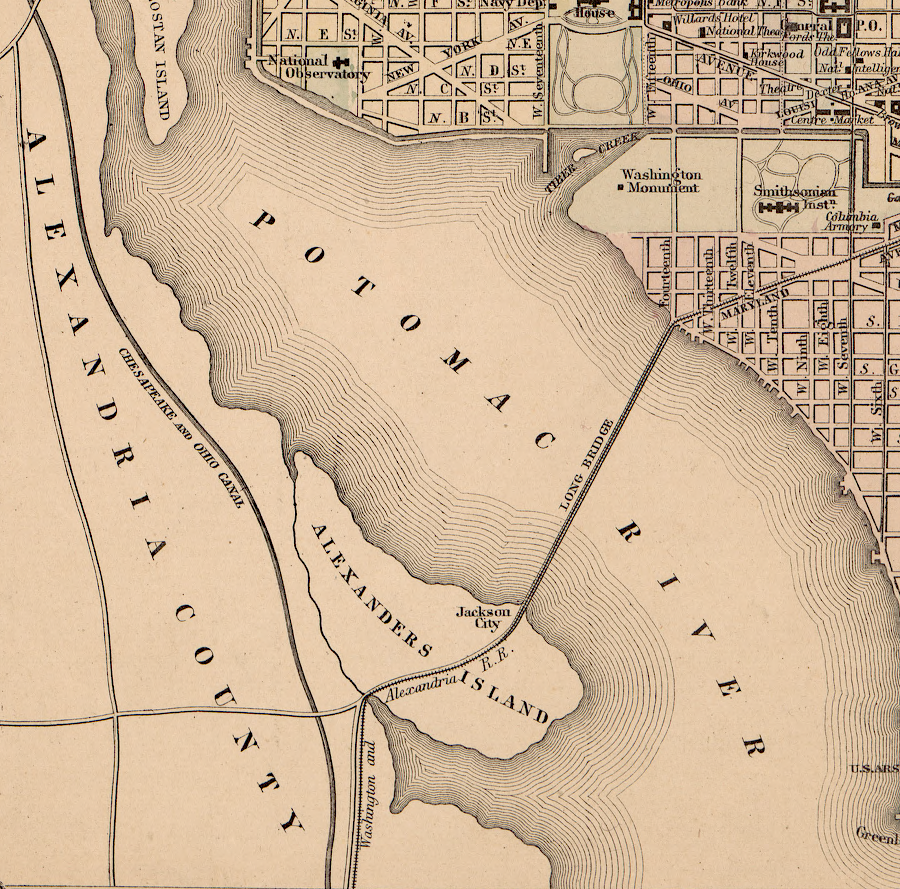
legal ownership of the Alexandria and Washington Railroad was returned to the original owners after the Civil War, and they renamed it the Washington and Alexandria Railway
Source: Library of Congress, Plan of the city of Washington : the capitol [sic] of the United States of America (by S. Augustus Mitchell, 1874)`
A Federal court, with a judge less sympathetic to ex-Confederate leaders than the Virginia state court, rejected that claim. The Federal judge determined that the Washington, Alexandria and Georgetown Railroad within the District of Columbia was a separate corporation from the Washington, Alexandria and Georgetown Railroad within Virginia. Had the Federal court ruled otherwise, former Confederates would have gained control over valuable track that had been financed by Union-sympathizing investors during the Civil War.1
William Bender Wilson, History of the Pennsylvania Railroad Company, Volume 1, Sherman Press, 1895, p.343, pp.352-353, pp.435-437, https://books.google.com/books?id=qj9N-eWi71YC; "An Archeological Assessment of the Southern Plaza Project Area Alexandria, Virginia," John Milner Associates, 1988, pp.16-17, https://www.alexandriava.gov/uploadedFiles/historic/info/archaeology/SiteReportSeifertSouthernPlazaUSMRR.pdf; "The Washington, Alexandria and Georgetown Railroad Co. vs. D. R. Martin et al," Supreme Court of the District of Columbia, 7 D.C. 120 (1870), https://cite.case.law/dc/7/120/; Robert Cohen, "History of the Long Railroad Bridge Crossing Across the Potomac River," Washington DC Chapter National Railway Historical Society, 2003, http://www.dcnrhs.org/learn/washington-d-c-railroad-history/history-of-the-long-bridge; "An Act to extend the Charter of the Alexandria and Washington Railroad Company, and for other Purposes," US Congress, 1863, https://www.loc.gov/law/help/statutes-at-large/37th-congress/session-3/c37s3ch110.pdf; Albert J. Churella, The Pennsylvania Railroad, Volume 1: Building an Empire, 1846-1917, University of Pennsylvania Press, 2012, pp.431-432, https://books.google.com/books?id=OXdjEZke74QC; Herbert H. Harwood Jr., Rails to the Blue Ridge: The Washington and Old Dominion Railroad, 1847-1968, Northern Virginia Regional Park Authority, 2000, p.14, https://www.google.com/books/edition/_/2GvQAAAACAAJ; Fairfax Harrison, A History of the Legal Development of the Railroad System of Southern Railway Company, 1901, p.1476, pp.1479-81, pp.1500-1501, https://books.google.com/books/about/A_History_of_the_Legal_Development_of_th.html?id=0IkjAQAAMAAJ; "French v. Hay," 89 U.S. 22 Wall. 250 250 (1874), https://supreme.justia.com/cases/federal/us/89/250/ (last checked August 2, 2020)

the Washington and Alexandria Railroad was the rail link between Long Bridge and Alexandria
Source: Library of Congress, Plan of the city of Washington: the capitol [sic] of the United States of America (by S. Augustus Mitchell, 1874)`
Though the Virginia investors gained legal control of the Washington and Alexandria Railway, they lacked the capital to maintain and operate it after the Civil War. The Baltimore and Ohio (B&O) Railroad leased the Washington and Alexandria Railway, the Long Bridge, and the tracks of the Washington, Alexandria and Georgetown Railroad within the District of Columbia. That railroad, which had exclusive access to Washington DC since 1835, obtained exclusive access to Alexandria.
There was little profit in extending Baltimore and Ohio Railroad service south from the District of Columbia to Alexandria, but the Baltimore and Ohio Railroad had expansion plans. It gained control over the Orange and Alexandria Railroad and planned to build or acquire additional railroads to create a network extending deep into the southern states. After the Civil War, the cost of acquisitions were low. Creating a large, integrated network of railroads stretching into Georgia and Alabama would bring business to Baltimore as the economy recovered in the former Confederate states.
The Pennsylvania Railroad had the same idea. In 1870 it maneuvered successfully in the US Congress for its Baltimore and Potomac Railroad subsidiary to get control of the track across Long Bridge, though it had to allow use by other railroads. In 1872 the Baltimore & Potomac (B&P) Railroad, under the control of the Pennsylvania Railroad, built track into the District of Columbia. The Pennsylvania Railroad also gained control over the Washington and Alexandria Railway in Virginia, the only railroad that provided access from the southern end of Long Bridge into Alexandria.
There was cutthroat competition between the Baltimore and Ohio Railroad and the Pennsylvania Railroad to gain control over the many bankrupt railroads in former Confederate states after the Civil War. The Pennsylvania Railroad used its Baltimore & Potomac (B&P) Railroad subsidiary, and its relationship with key officials in the District of Columbia, to arrange a deal with the District of Columbia government. The Pennsylvania Railroad was able to get local officials to block the Baltimore and Ohio Railroad from running any trains from its depot in Washington, DC to Long Bridge; the Washington, Alexandria and Georgetown Railroad track that provided the only connection to the northern end of Long Bridge was closed to Baltimore and Ohio Railroad traffic.
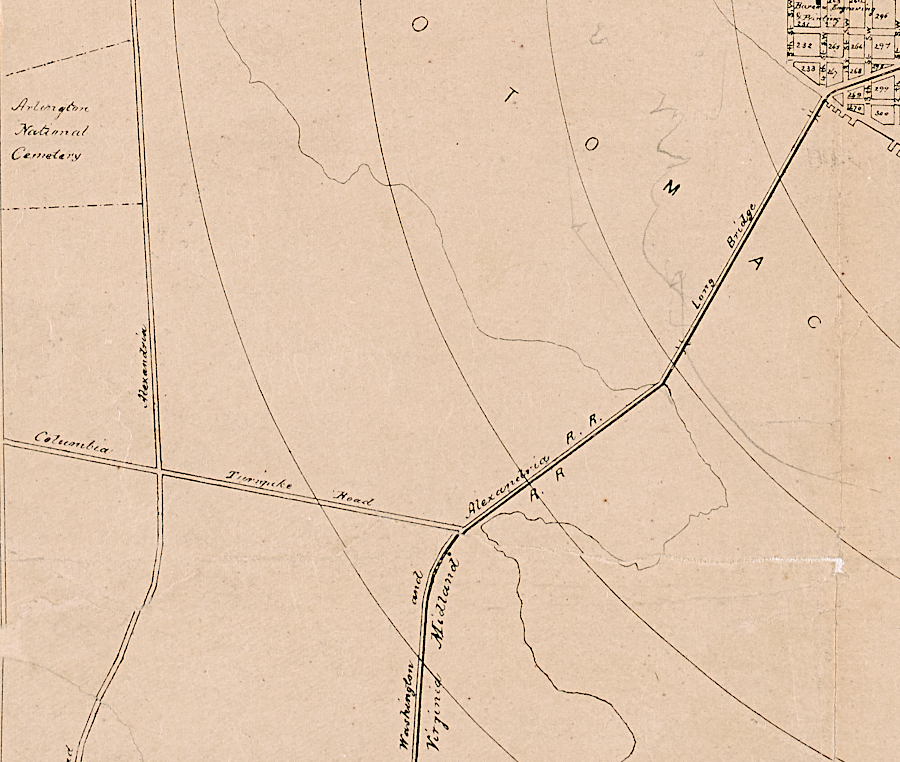
until 1904, the one railroad bridge over the Potomac River near Alexandria was part of or parallel to the highway bridge for wagons
Source: DC Public Library, Map of Washington, Georgetown and vicinity (by W. H. Morrison, 1882)`
The Pennsylvania Railroad's 1872 deal was negotiated with Alexander "Boss" Shepherd. He decided it was necessary to eliminate the bumps in District of Columbia roads associated with the Baltimore and Ohio Railroad tracks.
One night he ordered a crew of Irish workers to bury the rails used by the Baltimore and Ohio Railroad under 18" of dirt. The Baltimore and Ohio Railroad immediately mobilized a crew of African-American workers and brought them by train to 6th Street. They cleared the dirt off the rails as fast as Boss Shepherd's crew covered them. At one point the African-American workers were pushing dirt off the shovels of their Irish opponents before it could be tossed onto the rails, and for the moment kept the track open between Long Bridge and the Baltimore and Ohio Railroad depot.
That Baltimore and Ohio Railroad victory was short-lived. "Boss" Shepherd managed a few weeks later to have the Baltimore and Ohio Railroad track connecting to the Washington, Alexandria and Georgetown Railroad completely removed. That finally severed the connection of the Pennsylvania Railroad's competitor to the northern end of Long Bridge.
With "Boss" Shepherd's support, the Baltimore & Potomac Railroad (under the control of the Pennsylvania Railroad) then laid new track from Long Bridge north to its depot and opened a passenger station in 1873. The Pennsylvania Railroad had exclusive control over the connection to Alexandria, without any opportunity for the Baltimore and Ohio Railroad to use the track. The Baltimore & Potomac Railroad station on the Mall ended up being the location where an assassin shot President James Garfield in 1881. The station was torn down after Union Station opened in 1907.1
William Bender Wilson, History of the Pennsylvania Railroad Company, Volume 1, Sherman Press, 1895, pp.352-353, https://books.google.com/books?id=qj9N-eWi71YC; Robert Cohen, "History of the Long Railroad Bridge Crossing Across the Potomac River," Washington DC Chapter National Railway Historical Society, 2003, http://www.dcnrhs.org/learn/washington-d-c-railroad-history/history-of-the-long-bridge; "The Short-Lived Baltimore & Potomac Railroad Station on the National Mall," WETA - Boundary Stones local history blog, June 29, 2016, https://boundarystones.weta.org/2016/06/29/short-lived-baltimore-potomac-railroad-station-national-mall; Jay Roberts, "The East Alexandria Railroad," Jay's Jottings blog, November 17, 2016, https://jay.typepad.com/william_jay/2016/11/the-east-alexandria-railroad.html (last checked January 7, 2025)
In 1871, the Alexandria and Fredericksburg Railway linking Long Bridge to Alexandria was renamed the "Washington and Richmond Railway" to highlight that it could connect those two major cities. The line soon came under control of the Pennsylvania Railroad.
In 1872, the Pennsylvania Railroad used the charter of the Alexandria and Fredericksburg Railway to build new track in Virginia, going south from Long Bridge to Quantico. Long Bridge carried only one track across the Potomac River, but the Pennsylvania Railroad ended up with two tracks on the Virginia side connecting to Alexandria. The Baltimore and Potomac Railroad subsidiary of the Pennsylvania Railroad managed operations on the parallel tracks of both the Washington and Alexandria Railway and the Alexandria and Fredericksburg Railway, with a connection at St. Asaph Junction.
The dead-end track of the Washington and Alexandria Railway on North St. Asaph Street leading into Alexandria, ending at the former station on Princess Street, was no longer needed but was retained for potential future use. They ended up being used by Robert Portner to ship cold beer in refrigerated cars from his brewery located between Pendleton and Wythe streets to customers in southern states. That traffic ended when Virginia "went dry" in 1916, in advance of nationwide Prohibition.1
Jay Roberts, "Rails in the Seaport: A Brief Look at the History of Railroads and Their Tracks in Alexandria," Jay's Jottings blog, January 28, 2015, https://jay.typepad.com/william_jay/2015/01/rails-in-the-seaport-a-brief-look-at-the-history-of-railroads-and-their-tracks-in-alexandria.html (last checked January 6, 2025)
Having two tracks was an expensive duplication, but they provided the Pennsylvania Railroad with an insurance policy. The complicated legal claims regarding ownership of the Alexandria and Washington Railroad/Washington and Alexandria Railway created the risk that the Pennsylvania Railroad could lose control of it.
If the Baltimore and Ohio Railroad managed to acquire the Washington and Alexandria Railway, it would not make any money from owning an isolated stretch of rail south of Long Bridge - but it could block the Pennsylvania Railroad from using it. The Pennsylvania Railroad mitigated that risk by maintaining the parallel track of the Alexandria and Fredericksburg Railway/Washington and Richmond Railway between Long Bridge and Alexandria.
The Pennsylvania Railroad kept the Washington and Alexandria Railway and the Alexandria and Fredericksburg Railway as separate legal corporations until its ownership was solidified. In 1887, the Pennsylvania Railroad finally purchased all claims to the outstanding stock of the Washington and Alexandria Railway.1
H. W. Schotter, The growth and development of the Pennsylvania Railroad Company, Press of Allen, Lane & Scott, 1927, pp.217-218, https://hdl.handle.net/2027/uc1.$b38943; "The Bill As It Stood At Adjournment Yesterday Afternoon, With All The Adopted Amendments Inserted - February 14, 1871," Reconstructing Virginia, https://reconstructingvirginia.richmond.edu/items/show/1975 (last checked September 8, 2022)
In 1890, the Washington and Alexandria Railway and the Alexandria and Fredericksburg Railway finally were consolidated to form the Washington Southern Railway. The Richmond, Fredericksburg and Potomac Railroad was granted control over the track in 1901, and it became part of CSX in 1991.1
Fairfax Harrison, A History of the Legal Development of the Railroad System of Southern Railway Company, 1901, pp.1500-1501, https://books.google.com/books/about/A_History_of_the_Legal_Development_of_th.html?id=0IkjAQAAMAAJ; "Washington Southern Railway," Annual Report, Virginia, Railroad Commissioner, 1898, pp.3-4, p.30, https://books.google.com/books?id=mCUaAQAAIAAJ; "Talking Deals; CSX and Virginia Split a Company," New York Times, July 18, 1991, https://www.nytimes.com/1991/07/18/business/talking-deals-csx-and-virginia-split-a-company.html (last checked August 2, 2020)
The Alexandria and Washington Railroad provided the first connection between Long Bridge and Alexandria, but its charter was not used by the Pennsylvania Railroad for the connection south to Fredericksburg. Instead, the Alexandria and Fredericksburg Railway charter was used to authorize building track south from Alexandria to Quantico.
Charters for two other railroads were used to build north from Fredericksburg to Quantico. The Richmond, Fredericksburg and Potomac (RF&P) Railroad built a 10-mile branch line north from the end of its track near Aquia Landing. Its charter from the General Assembly limited construction of branch lines to just 10 miles, and the meeting point at Quantico was almost 12 miles away. A separate corporation, the Potomac Railroad, provided the solution. The Richmond, Fredericksburg and Potomac Railroad used the charter of the Potomac Railroad to build the last 1.7 miles of additional track north of the RF&P's endpoint to reach Quantico.1
Charles Thomas, "The Development of the Railroads in Washington," The Railway and Locomotive Historical Society Bulletin, Number 105 (October 1961), p.28, https://www.jstor.org/stable/43520286; "Washington Southern Railway," Annual Report, Virginia, Railroad Commissioner, 1898, p.20, https://books.google.com/books?id=mCUaAQAAIAAJ (last checked June 2, 2020)
Completion of track to Quantico in 1872 finally established a direct rail connection between all of the Fall Line cities in Virginia, from Alexandria to Emporia.
In 1890, the Potomac Railroad and the Alexandria and Fredericksburg Railway were consolidated into the Washington Southern Railway, which was controlled by the Pennsylvania Railroad. Trains moving south of Alexandria to Richmond used the tracks controlled by the Pennsylvania Railroad to Quantico, and then track of the Richmond, Fredricksburg and Potomac (RF&P) Railroad to get further south to Richmond.
The separate railroads between Alexandria and Long Bridge, the Alexandria and Washington Railroad and the Alexandria and Fredericksburg Railway, were also consolidated into the Washington Southern Railway Company in 1890.
The rivalries between the six railroads serving Alexandria were resolved and, through a joint agreement, they opened the Alexandria Union Station on September 1905 for passengers riding on the hesapeake and Ohio, Southern and Richmond, Fredricksburg and Potomac (RF&P) railroads. Freight operations were consolidated at Potomac Yard, which opened on August 1, 1906.
There was enough industry on the Virginia shoreline of the Potomac River noerth of Alexandria to justify expanding the Washington Southern Railway. The Pennsylvania Railroad arranged for the Rosslyn Connecting Railroad to build 2.7 miles of standard gauge track north from Long Bridge to Rosslyn in 1904. Construction of the Memorial Bridge required the US Congress to authorize the Federal government in 1931 to exchange lands with the railroad, to align the existing tracks with the new road. The Rosslyn Connecting Railroad also survived construction of the Pentagon. 1
"WikiProject Trains/ICC valuations/Rosslyn Connecting Railroad," Wikipedia, https://en.wikipedia.org/wiki/Wikipedia:WikiProject_Trains/ICC_valuations/Rosslyn_Connecting_Railroad; "An Act Authorizing the Secretary of War to exchange with the
Rosslyn Connecting Railroad Company lands on the Virginia shore of the Potomac River near the west end of the Arlington Memorial Bridge," US Congress, February 20, 1931, https://maint.loc.gov/law/help/statutes-at-large/71st-congress/session-3/c71s3ch248.pdf; "The Alexandria Union Station," Historic Alexandria Quarterly, Volume 1, Number 1 (Winter 1996), https://media.alexandriava.gov/docs-archives/historic/haq/historicalexandriaquarterly1996winter1.pdf (last checked February 15, 2025)
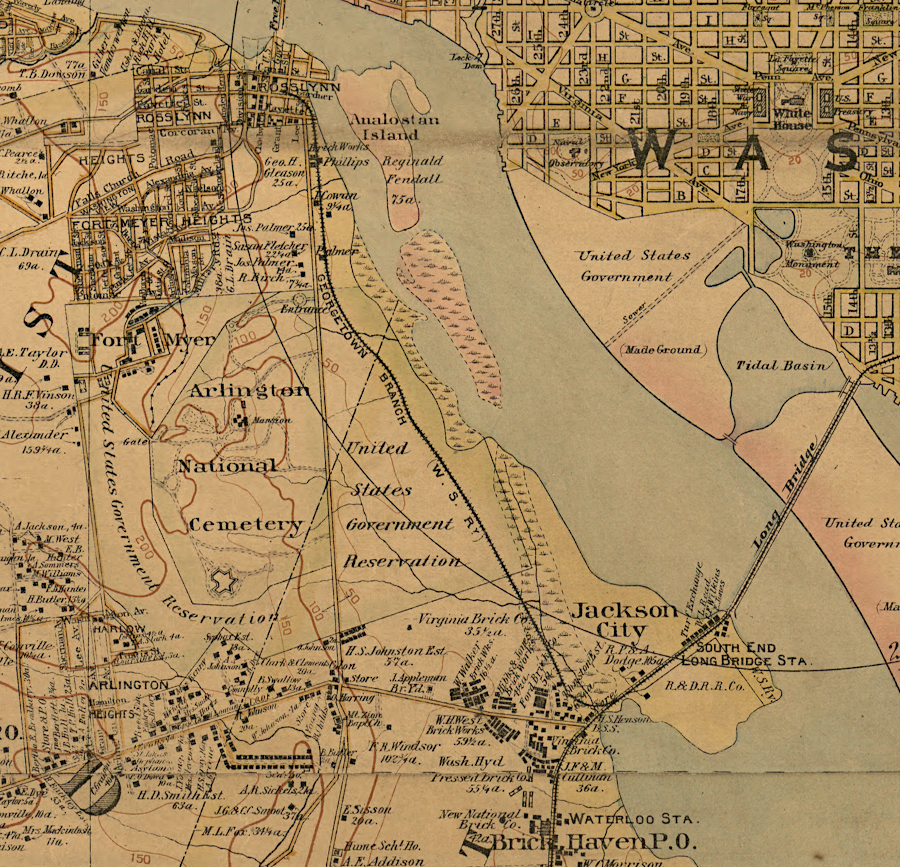
the Pennsylvania Railroad built the Rosslyn Connecting Railroad (labeled "Georgetown Branch") to carry freight from industries near Rosslyn to the Washington Southern Railway at Long Bridge
Source: Library of Congress, The vicinity of Washington, D.C. (by Griffith Morgan, Jr., c.1894)
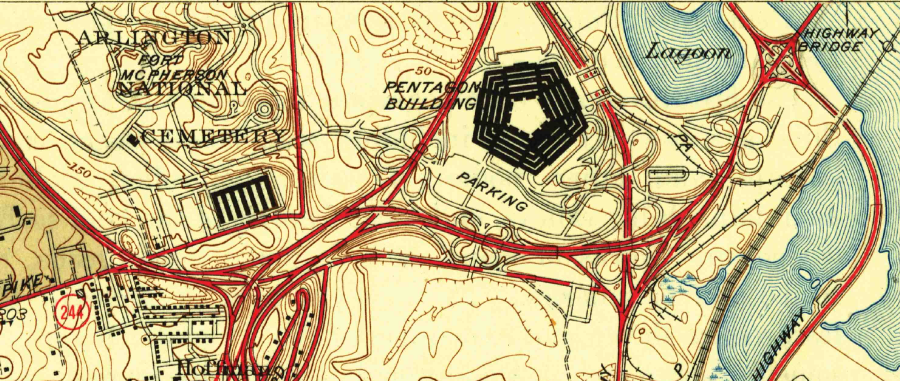
the Rosslyn Connecting Railroad passed between the Pentagon and the Potomac River
Source: US Geological Survey, Alexandria, VA 1:31,680 scale topographic quadrangle (1945)
Governor Northam announced the $3.7 billion Transforming Rail in Virginia initiative in 2021. As part of the investment in new infrastructure to expand passenger rail capacity, the Virginia Passenger Rail Authority was funded to add a fourth track between Long Bridge and the interlocking with CSX, the AF TOWER rail junction west of Alexandria Station. Adding the fourth track was expected to reduce conflicts between freight and passenger trains and increase reliability of Amtrak to get to stations on schedule.1
"Alexandria Fourth Track," Virginia Passenger Rail Authority, https://vapassengerrailauthority.org/alexandria-fourth-track/#doc-library; "Northam, Buttigieg Announce Virginia Rail Infrastructure Upgrades," Virginia Public Media, March 30, 2021. https://www.vpm.org/news/2021-03-30/northam-buttigieg-announce-virginia-rail-infrastructure-upgrades (last checked January 7, 2025)
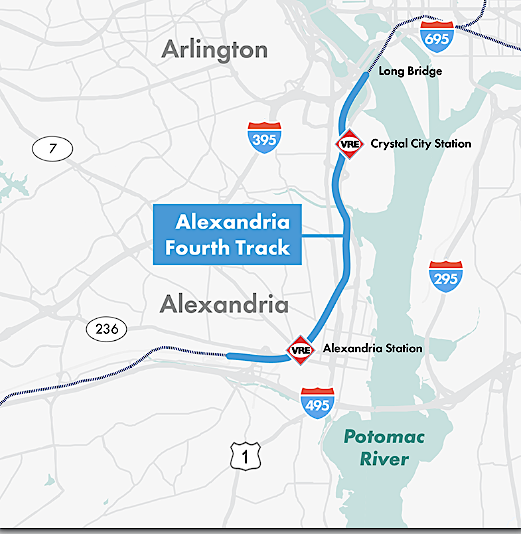

the fourth track adds capacity between Long Bridge to west of Alexandria Union Station (RO to AF junctions), reducing conflicts between freight and passenger trains
Source: Virginia Passenger Rail Authority, Alexandria Fourth Track
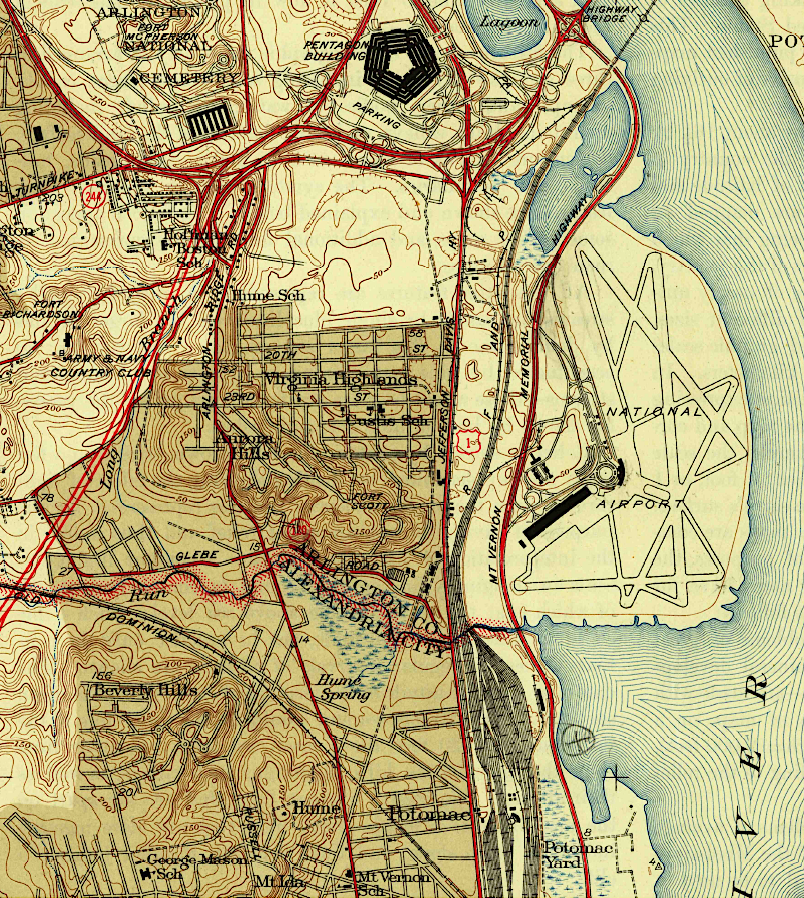
the Richmond, Fredericksburg and Potomac (RF&P) Railroad owned the track between Potomac Yard and 14th Street Bridge in 1945
Source: US Geological Survey, Alexandria, VA 1:31,680 scale topographic quadrangle (1945)
Links
- Civil War History
- Library of Congress
References
1.
2.
3.
4.
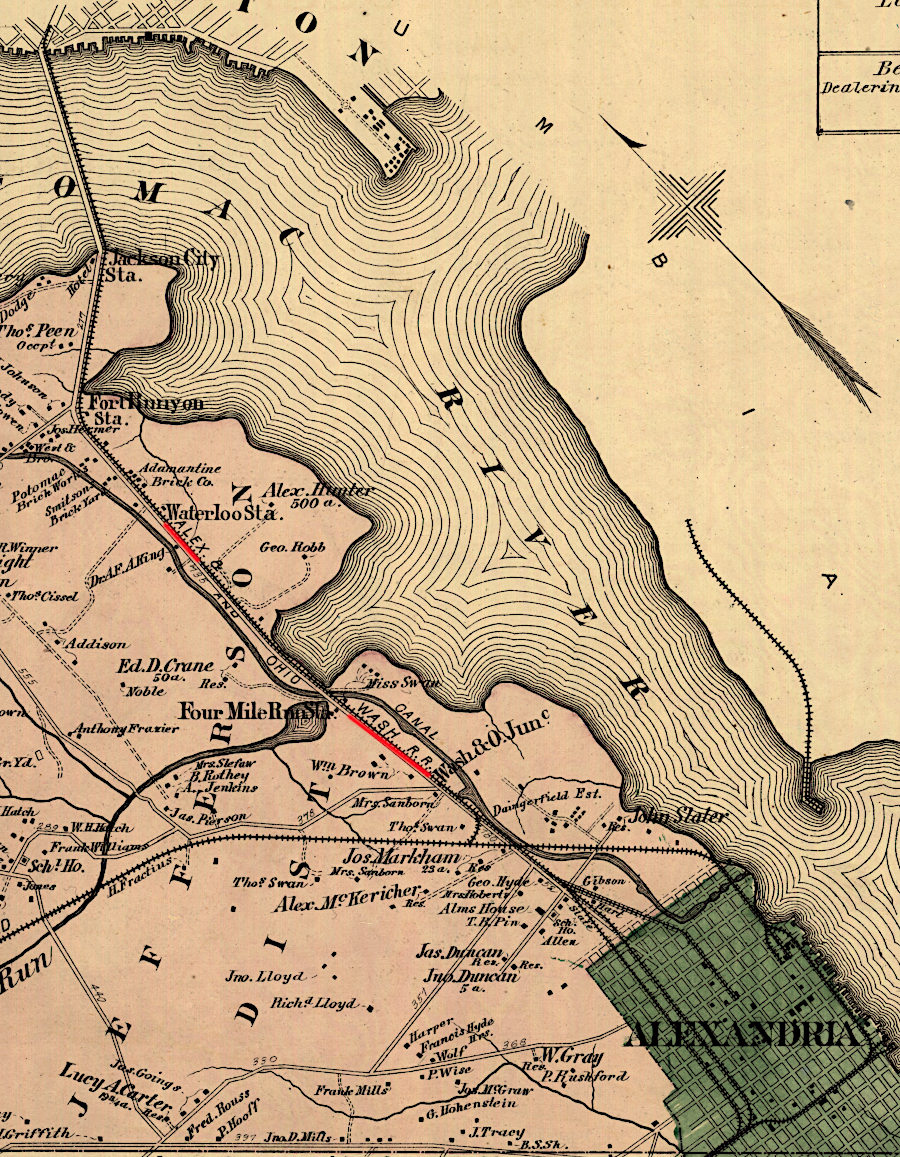
the route of the Alexandria and Washington Railroad has been used by different railroads since 1857
Source: Library of Congress, Atlas of fifteen miles around Washington, including the counties of Fairfax and Alexandria, Virginia (by Griffith Morgan Hopkins Jr., 1879)
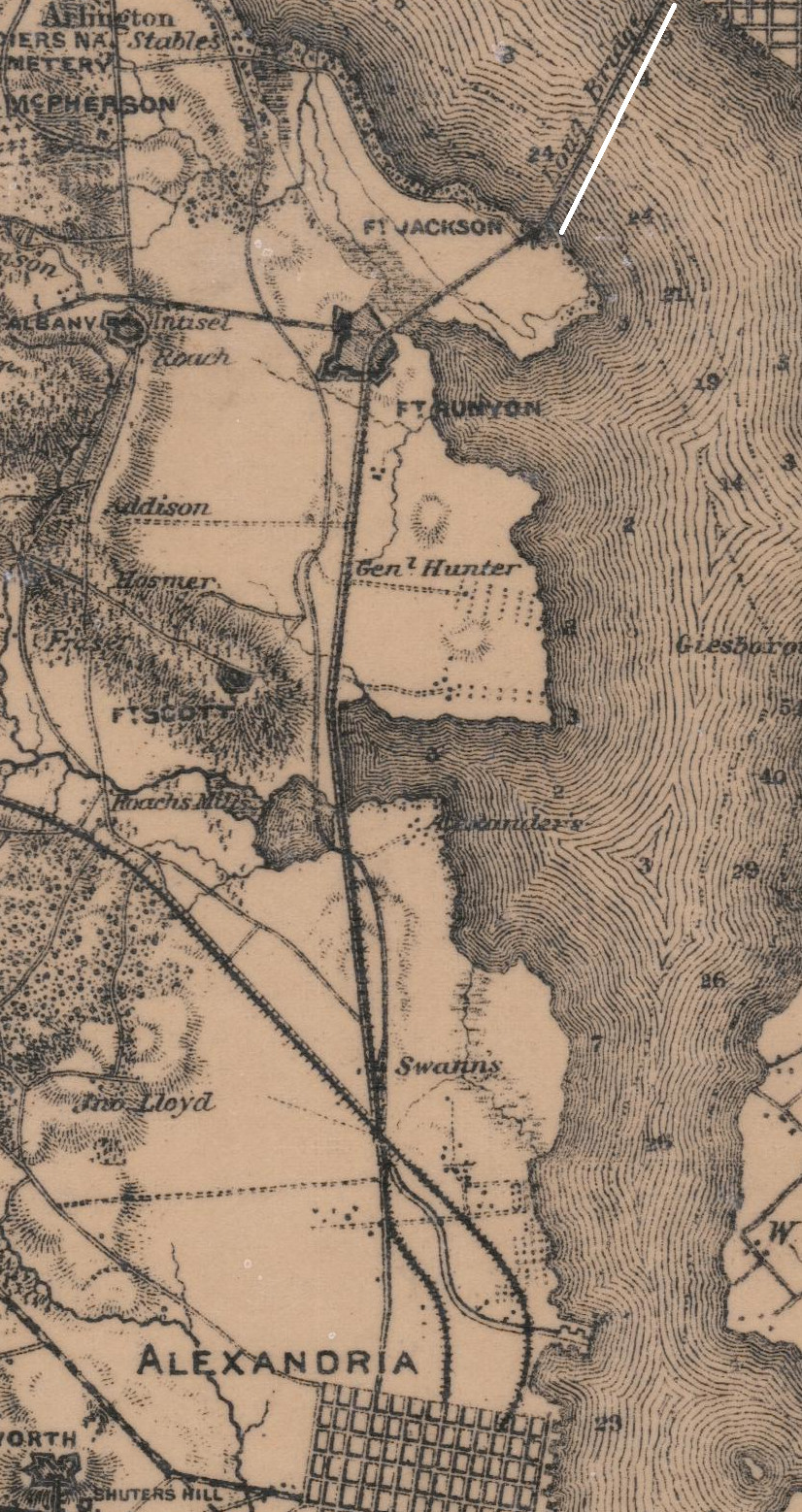
Union troops rebuilt the Alexandria and Washington Railroad up to Long Bridge
Source: National Archives, Extract of Military Map of Northeast Virginia, Showing Forts and Roads (1865)
Railroads of Virginia
Virginia Places















